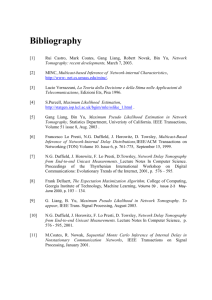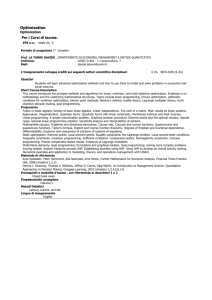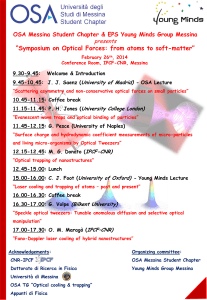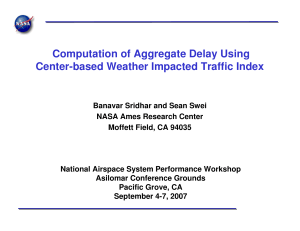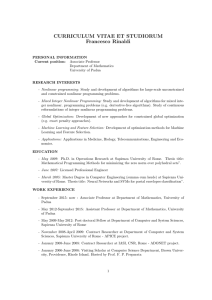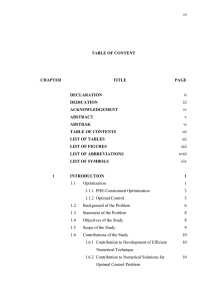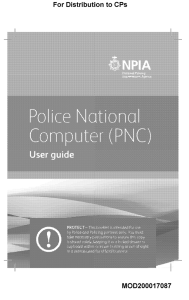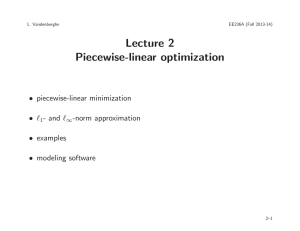Emerging Needs for Evolving Hybrid Energy Cyber‐Physical System (e‐CPS) Sudip. K. Mazumder
advertisement
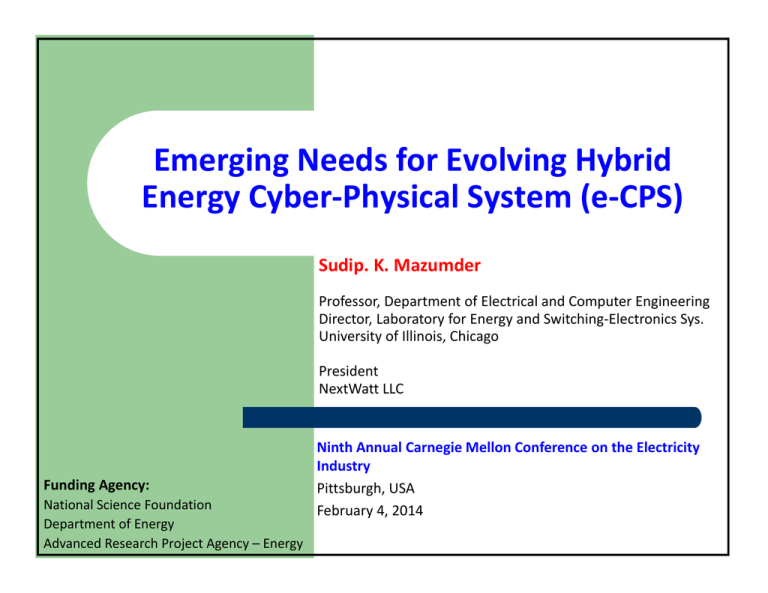
Emerging Needs for Evolving Hybrid Energy Cyber‐Physical System (e‐CPS) Sudip. K. Mazumder Professor, Department of Electrical and Computer Engineering Director, Laboratory for Energy and Switching‐Electronics Sys. University of Illinois, Chicago President NextWatt LLC Funding Agency: National Science Foundation Department of Energy Advanced Research Project Agency – Energy Ninth Annual Carnegie Mellon Conference on the Electricity Industry Pittsburgh, USA February 4, 2014 Challenges of e‐CPS Power, communication, information, sensing, financial networks Some estimates: 100 X+ Interop erability Dimensi onality Data integrity, known/unknown undesirable pattern Security recognition Optimization in the presence of interoperability constraints Nano seconds to hours Scale e‐CPS Controll ability Optimal ity Observa bility Spatio‐temporal power management and control with distributed functionalities under nominal and singular conditions Estimation in the presence of (real‐time) data proliferation, uncertainties e‐CPS: Great, but how do we tackle the giant? Think of a “slightly” bigger giant: The Universe which works so amazingly E8: A theory of everything Courtesy John Stembridge/Atlas of Lie Groups Project “Understanding the interplay between small and large is the key to the solution” e‐CPS modeling challenges Unified dynamical modeling that captures hybrid, functional, event‐ driven, and stochastic dynamics with cross‐disciplinary inter‐ dependencies Representation of multi‐scale, multi‐dimensional, and nonlinear spatio‐temporal dynamics at varying levels of abstraction, granularity and aggregation Generalized approach(es) to contingency, stability, robustness, and reliability analyses that is (are) scalable, seamless, computationally efficient, and can provide offline and real‐time measure and predictions e‐CPS control challenges Optimal networked‐control to sustain distributed operation under communication‐network’s capacity and power‐network’s stability bounds in the presence of nodal and network uncertainty, stochasticity, and destabilization Jointly optimize control of the power network over the communication network and control of the information‐flow network itself Unification of event‐driven control, protection using rapid solid‐ state switching, and distributed coordination Robustness of control in the presence of uncertainty in the truthfulness and accurate representation of the measured/ estimated data Few Illustrations …. Illustration 1 Network architectures for control of inverters Centralized Distributed Master Controller “Collective” Cluster Controller Communication Network PN3 PN1 LC3 LC1 PN3 PN1 LC4 LC2 PN4 PN2 Power Network PN: Power Node PN4 PN2 Power Network PN: Power Node LC: Local Controller Control distribution X Cost: X * gX P X T * X Constraints: X t 0 ,α i i 1 h , , X t 0 Tw f Tw ,Ai i 1 h ,Bi i 1 h X t 0 Tw X max , i 1 αi 1, h T and 0 αi 1 X 1 t 0 Tw1 i 11 1i h S.K. Mazumder, K. Acharya, and M. Tahir, “Joint optimization of control performance and network resource utilization in homogeneous power networks”, IEEE Transactions on Industrial Electronics, vol. 56, no. 5, pp. 1736‐1745, 2009. 1, and 0 1i 1 Cost: X * X T P X * X N N N N N Constraints: X N t 0 TwN i N1 Ni h X1* g1' X1 , D1 X 1 t 0 , 1i i 1 h ,Tw1 , 1 , f1 A1i i 1 h , B1i i 1 h ,W1 1 1 X 1max , Module N X N t 0 TwN 8 X 1 P1 X 1* X 1 X 1 t 0 Tw1 Cost and Constraint Decomposition Cost: * 1 Constraints: Centralized Control J X* X Module 1 X *N g'N X N , DN X N t 0 , N i i 1 h ,TwN , N , f N AN i i 1 h , B N i i 1 h ,W N N N X N max , 1, and 0 N i 1 Module power control for distributed implementation Power Stage Time delayed information from other modules Optimal Performance Control Local sensor information Reachable Switching Sequences Stability Prediction Hybrid Dynamical Model Information to other modules Information Processing S.K. Mazumder and K. Acharya, “Multiple Lyapunov function based reaching criteria for orbital existence of switching power converters”, IEEE Transactions on Power Electronics, vol. 23, no. 3, pp. 1449‐1471, 2008. Communication network throughput optimization maximize si U (rsi ) l rsi l L ( s i ) Rmin(si ) rsi s.t rs i si l s l s (d (q) dl(t ) ) si l minimize (qi) (t )i Dmax (si ) 2dl l 2dl si :lL( si ) maximize si (1 si ) (1 si ) ( si ) dl(q) , dl(t ) minimize g (λ, ρ, ψ) s.t l , l , si 0 l , s i si As in the case of the control sub‐problem, communication network optimization can also be performed centrally or in a distributed manner si l , l 0 si 0 s.t 0 si 1 si ( )R e e k minimize l l l Pl ~ tl l ~ tl ck l s.t ~ tl ck ~min (l ) l maximize l maximize g P ( ) s.t l 0 l log( l (P)) l s.t 0 Pl Pmax l l , l , s i M. Tahir and S.K. Mazumder, “Delay constrained optimal resource utilization of wireless networks for distributed control systems”, IEEE Communication Letters, vol. 12, no. 4, pp. 289‐291, 2008. Non‐cooperative control‐communication scenario 1 Stability Margin 800 Optimal Network Throughput (Mbps) Delay Margin (μs) 1000 600 400 200 0 0 Performance Margin 200 400 600 800 Time Delay (μs) Variations of the stability and performance margins in terms of delay margin 0.9 0.8 0.7 0.6 0.5 500 1000 1500 2000 2500 Time Delay (μs) Achievable optimal network throughput as a function of the network time delay Tradeoff, with regard to network time delay, between control performance and stability and resource utilization of the communication network Joint optimization PN X(t ) Control Parameters X(t ) PN Optimization Framework A J *PN ( ) d th SINR l ∑ Jo + 1 A 0i Bi PN Model × + Weight Calculation Stability Margin Calculation PN Optimization Block ( ) 1 Joint J *o Optimization Block *( ) d ( ) d th CN Optimization Framework × J *CN PN: power network CN: communication network SINR: Signal‐to‐interference noise ratio CN Optimization Block c l (P) r* , Pl* CN SINR l CN Model 5 0.25 4 0.2 3 0.15 2 0.1 Centralized 1 0.05 Distributed 0 0 1 2 3 4 5 Number of Modules 6 7 Normalized Convergence Time Load‐sharing Error (%) Results (centralized vs. distributed control) Illustration 2 ARPA‐E project – Collaboration between UIC, Silicon Power, Cree World’s first all‐optical 15‐kV/10‐kHz/2‐kA SiC ETO Control of system at device level Control of EM signature, switching loss, dv/dt, di/dt stress (also enables series/parallel connection of PSDs) • Intensity and/or wavelength of optical signal controls PSD switching dynamics • Duration, frequency, and placement of optical pulse controls PSD switching sequence Control of system performance and stability, EM signature, switching loss PSD commutation stress Electromagnetically-shielded Optical control signal Switching-sequence and switching-transition controller Light source High power stage Electromagnetic immunity and optical isolation Optical detector and sensor Optical sensor signal OTPT PSD Power Optically-triggered Semiconductor Device (PSD) Circuit RF band Optics Hz 100 102 104 106 108 1010 1012 1014 1016 Dynamic control of device dynamics for rapid fault mitigation, power quality, and multi‐scale power management Illustration 3 Boolean microgrid* * Patent pending Power transfer over a pulsating‐ dc voltage link (PDVL) Source Microgrid Load Discretized power and data delivery A simple realization for discretized power flow 17 Thank You! Elementary to composite particles Matter Quarks Leptons Hadrons Mesons Baryons Nuclei Atoms Molecules
